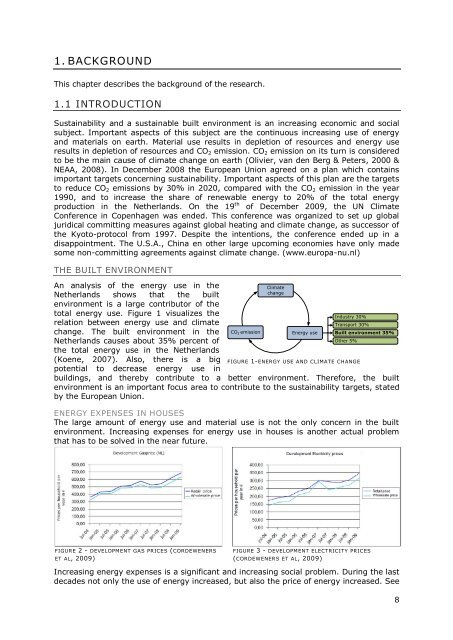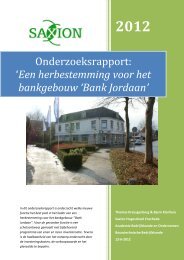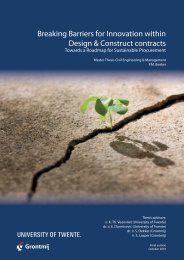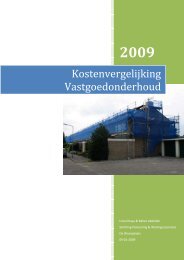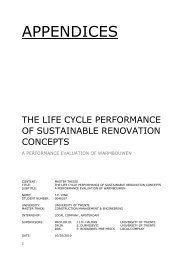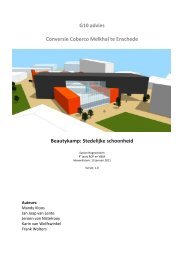the life cycle performance of sustainable renovation concepts
the life cycle performance of sustainable renovation concepts
the life cycle performance of sustainable renovation concepts
- No tags were found...
Create successful ePaper yourself
Turn your PDF publications into a flip-book with our unique Google optimized e-Paper software.
1. BACKGROUNDThis chapter describes <strong>the</strong> background <strong>of</strong> <strong>the</strong> research.1.1 INTRODUCTIONSustainability and a <strong>sustainable</strong> built environment is an increasing economic and socialsubject. Important aspects <strong>of</strong> this subject are <strong>the</strong> continuous increasing use <strong>of</strong> energyand materials on earth. Material use results in depletion <strong>of</strong> resources and energy useresults in depletion <strong>of</strong> resources and CO 2 emission. CO 2 emission on its turn is consideredto be <strong>the</strong> main cause <strong>of</strong> climate change on earth (Olivier, van den Berg & Peters, 2000 &NEAA, 2008). In December 2008 <strong>the</strong> European Union agreed on a plan which containsimportant targets concerning sustainability. Important aspects <strong>of</strong> this plan are <strong>the</strong> targetsto reduce CO 2 emissions by 30% in 2020, compared with <strong>the</strong> CO 2 emission in <strong>the</strong> year1990, and to increase <strong>the</strong> share <strong>of</strong> renewable energy to 20% <strong>of</strong> <strong>the</strong> total energyproduction in <strong>the</strong> Ne<strong>the</strong>rlands. On <strong>the</strong> 19 th <strong>of</strong> December 2009, <strong>the</strong> UN ClimateConference in Copenhagen was ended. This conference was organized to set up globaljuridical committing measures against global heating and climate change, as successor <strong>of</strong><strong>the</strong> Kyoto-protocol from 1997. Despite <strong>the</strong> intentions, <strong>the</strong> conference ended up in adisappointment. The U.S.A., China en o<strong>the</strong>r large upcoming economies have only madesome non-committing agreements against climate change. (www.europa-nu.nl)THE BUILT ENVIRONMENTAn analysis <strong>of</strong> <strong>the</strong> energy use in <strong>the</strong>Ne<strong>the</strong>rlands shows that <strong>the</strong> builtenvironment is a large contributor <strong>of</strong> <strong>the</strong>total energy use. Figure 1 visualizes <strong>the</strong>relation between energy use and climatechange. The built environment in <strong>the</strong>Ne<strong>the</strong>rlands causes about 35% percent <strong>of</strong><strong>the</strong> total energy use in <strong>the</strong> Ne<strong>the</strong>rlands(Koene, 2007). Also, <strong>the</strong>re is a bigpotential to decrease energy use inCO2 emissionClimatechangeEnergy useIndustry 30%Transport 30%FIGURE 1-ENERGY USE AND CLIMATE CHANGEBuilt environment 35%O<strong>the</strong>r 5%buildings, and <strong>the</strong>reby contribute to a better environment. Therefore, <strong>the</strong> builtenvironment is an important focus area to contribute to <strong>the</strong> sustainability targets, statedby <strong>the</strong> European Union.ENERGY EXPENSES IN HOUSESThe large amount <strong>of</strong> energy use and material use is not <strong>the</strong> only concern in <strong>the</strong> builtenvironment. Increasing expenses for energy use in houses is ano<strong>the</strong>r actual problemthat has to be solved in <strong>the</strong> near future.FIGURE 2 - DEVELOPMENT GAS PRICES (CORDEWENERSET AL, 2009)FIGURE 3 - DEVELOPMENT ELECTRICITY PRICES(CORDEWENERS ET AL, 2009)Increasing energy expenses is a significant and increasing social problem. During <strong>the</strong> lastdecades not only <strong>the</strong> use <strong>of</strong> energy increased, but also <strong>the</strong> price <strong>of</strong> energy increased. See8


